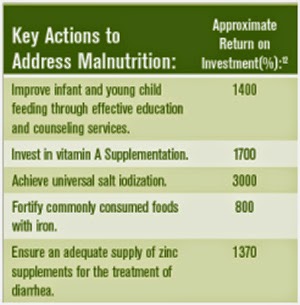By Tiruni Yasaratne, Global Health Researcher Volunteer
In 2013, the Lancet published an ‘eyebrow raising’ statistic: undernutrition contributes to 45% of all child mortality worldwide. Of the seven million children around the world who die before their fifth birthday, nearly half of these die from undernutrition. Undernutrition, is in fact, a major global public health problem, with almost one in four children under-five stunted and 52 million children wasted.
The World Bank “At a glance” nutrition series shows that the economic costs of undernutrition include direct costs such as increased burden on health care systems, and indirect costs of lost productivity. Childhood anemia alone is associated with 5% drop in future adult wages!
Donor nations, countries and agencies came together in June 2013 at the Nutrition for Growth Summit in London, and made pledges for increased spending on nutrition interventions. Australia committed $40 million over four years for nutrition activities in the region.
A recent report, "Undernutrition in the Land of Rice", by RESULTS UK and RESULTS Australia on undernutrition in Cambodia reveals some distressing facts:
- On average undernourished children enroll in school later and complete fewer years of school
- Only a third of undernourished children go on to secondary school with completion rates very low
- Undernourished children have weakened immune systems and are more likely to contract communicable diseases (TB for example) – Studies in India show that a patient who is diagnosed with TB and also undernourished is two times more likely to die than a non-malnourished TB patient!
- Maternal undernutrition is high – Anaemia caused by low consumption of iron rich foods is very high in women of reproductive age and is a leading cause of maternal deaths and linked to adverse birth outcomes such as low weight babies. It also leads to reduced ability to concentrate, and ability to do manual labour.
A common understanding in the development community is that economic growth will improve nutrition. The Cambodian case proves otherwise. Sadly, Cambodia is far from unique in struggling with this issue –14 countries have a child stunting rate of over 30% in the Asia Pacific region.
Economic growth needs to be funneled in a targeted way to have an improvement on nutrition. Too often nutrition has been neglected, as there’s no easy single solution to implement. Our Cambodian report advocates for a stand alone indicator on nutrition and food security to be incorporated into the post-2015 development goals, to ensure nutrition is prioritised.
In a nutshell, Cambodia needs to invest more in nutrition interventions. But in a country with already competing development priorities, is it a cost effective option?
In 2013, the Lancet brought together the worlds nutrition experts, who found that a combination of ten interventions can make significant improvements in nutritional status at a relatively low cost.
Areas worthy of scale up include:
- Infant feeding practices - Support early start of breastfeeding (within the hour), continued exclusive breastfeeding until age six months, and timely introduction of complementary foods;
- Access to a diverse range of food through crop diversification;
- Nutrition education, in schools and primary health care centres, and by community health workers;
- Micronutrient fortification - According to the Micronutrient Initiative, “specifically providing vitamin A and zinc, provides the most beneficial return on investment of any development intervention”. Fortification is also most successful when it is mandated by law.
- Conditional Cash Transfers- These provide a small income to families, with a conditional element that encourages them to engage with social programmes, including health and primary education. Evidence from major programmes (e.g. in Mexico and Brazil) shows that the interventions are most effective when they reach children during their first two years of life.
- Access to water and sanitation to combat disease - WHO estimates that 50% of undernutrition is associated with intestinal worm infections or repeated diarrhoeal episodes due to insufficient access to clean water and sanitation.
Amazingly, scaling up core micronutrient interventions would cost less than US$6 million per year. Addressing undernutrition is cost effective: Costs of core micronutrient interventions are as low as US$0.05–3.60 per person annually. Returns on investment areas high as 8–30 times the costs!
The World Bank states the returns on investment for addressing malnutrition include:
Source: The World Bank – Nutrition at a glance/Cambodia
Donor agencies, including Australia should publicise examples of their spending on nutrition interventions. Australia initiated the development of a holistic nutrition strategy soon after the London summit. However, due to changes in the aid programme in late 2013, there are no visible developments on it.
It is obvious that investing in nutrition programmes is tremendous value for money. With more bang for your buck, it is essentially an investment and not a cost. Keeping in line with new changes in Australian foreign aid whereby the Federal Government will soon introduce a performance evaluation system for foreign aid, with an emphasis on value for money, moving forward on the undernutrition strategy and developing comprehensive aid solutions to undernutrition is crucial for effective Australian aid.
Read the full report "Undernutrition in the Land of Rice"


No comments:
Post a Comment